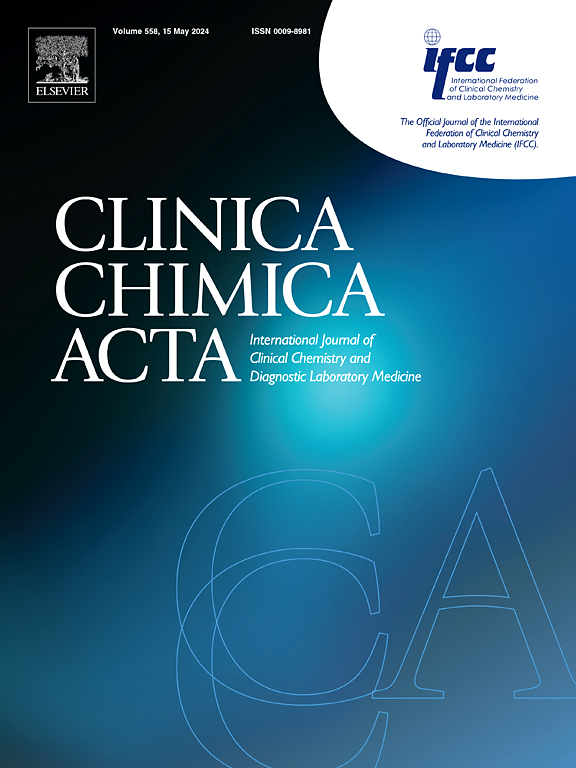Non-coding RNAs in thoracic disease: Barrett’s esophagus and esophageal adenocarcinoma
IF 3.2
3区 医学
Q2 MEDICAL LABORATORY TECHNOLOGY
引用次数: 0
Abstract
Esophageal adenocarcinoma (EAC) is a highly aggressive malignancy with increasing incidence and poor survival rates, primarily due to late-stage diagnosis. This cancer often develops from Barrett’s Esophagus (BE), a precancerous condition linked to chronic gastroesophageal reflux disease (GERD). The transition from BE to EAC is a complex multistep process involving numerous genetic, epigenetic, and molecular changes that lead to the malignant transformation of the esophageal epithelium. Despite advancements in understanding the molecular mechanisms underlying EAC, early detection and effective treatment options remain limited, highlighting an urgent need for innovative diagnostic and therapeutic strategies. Recent research has focused on non-coding RNAs (ncRNAs), which play crucial roles in regulating gene expression and cellular processes relevant to cancer progression. Various types of ncRNAs, including microRNAs, long non-coding RNAs, and circular RNAs, have been implicated in the development of BE and EAC by modulating key signaling pathways such as Wnt/β-catenin and NF-κB. Additionally, ncRNAs are stable in biological fluids, presenting opportunities for their use as non-invasive biomarkers for early detection and monitoring of EAC. This review aims to elucidate the involvement of ncRNAs in the progression from BE to EAC, their potential as therapeutic targets, and their emerging roles in intercellular communication. We will also discuss the challenges in translating ncRNA research into clinical applications, emphasizing their promise in revolutionizing early detection and treatment strategies for EAC.
非编码rna在胸部疾病:Barrett食管和食管腺癌中的作用。
食管腺癌(EAC)是一种高度侵袭性的恶性肿瘤,发病率上升,生存率低,主要是由于晚期诊断。这种癌症通常由巴雷特食管(BE)发展而来,这是一种与慢性胃食管反流病(GERD)有关的癌前病变。从BE到EAC的转变是一个复杂的多步骤过程,涉及许多导致食管上皮恶性转化的遗传、表观遗传和分子变化。尽管在了解EAC的分子机制方面取得了进展,但早期发现和有效治疗方案仍然有限,因此迫切需要创新的诊断和治疗策略。最近的研究集中在非编码rna (ncRNAs)上,它们在调节与癌症进展相关的基因表达和细胞过程中起着至关重要的作用。各种类型的ncrna,包括microrna、长链非编码rna和环状rna,通过调节关键信号通路(如Wnt/β-catenin和NF-κB)参与BE和EAC的发展。此外,ncrna在生物体液中是稳定的,这为它们作为早期检测和监测EAC的非侵入性生物标志物提供了机会。这篇综述旨在阐明ncrna在BE到EAC过程中的参与,它们作为治疗靶点的潜力,以及它们在细胞间通讯中的新作用。我们还将讨论将ncRNA研究转化为临床应用所面临的挑战,强调它们在EAC的早期检测和治疗策略方面的革命性前景。
本文章由计算机程序翻译,如有差异,请以英文原文为准。
求助全文
约1分钟内获得全文
求助全文
来源期刊

Clinica Chimica Acta
医学-医学实验技术
CiteScore
10.10
自引率
2.00%
发文量
1268
审稿时长
23 days
期刊介绍:
The Official Journal of the International Federation of Clinical Chemistry and Laboratory Medicine (IFCC)
Clinica Chimica Acta is a high-quality journal which publishes original Research Communications in the field of clinical chemistry and laboratory medicine, defined as the diagnostic application of chemistry, biochemistry, immunochemistry, biochemical aspects of hematology, toxicology, and molecular biology to the study of human disease in body fluids and cells.
The objective of the journal is to publish novel information leading to a better understanding of biological mechanisms of human diseases, their prevention, diagnosis, and patient management. Reports of an applied clinical character are also welcome. Papers concerned with normal metabolic processes or with constituents of normal cells or body fluids, such as reports of experimental or clinical studies in animals, are only considered when they are clearly and directly relevant to human disease. Evaluation of commercial products have a low priority for publication, unless they are novel or represent a technological breakthrough. Studies dealing with effects of drugs and natural products and studies dealing with the redox status in various diseases are not within the journal''s scope. Development and evaluation of novel analytical methodologies where applicable to diagnostic clinical chemistry and laboratory medicine, including point-of-care testing, and topics on laboratory management and informatics will also be considered. Studies focused on emerging diagnostic technologies and (big) data analysis procedures including digitalization, mobile Health, and artificial Intelligence applied to Laboratory Medicine are also of interest.
 求助内容:
求助内容: 应助结果提醒方式:
应助结果提醒方式:


